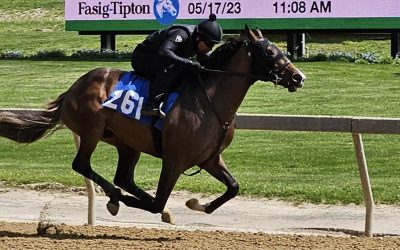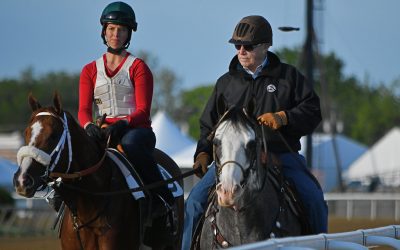What the new Maryland “house rules” mean

Photo by The Racing Biz.
The bevy of equine safety-related measures heard by the Maryland Racing Commission at its October meeting have colloquially been referred to as “house rules.”
In fact, however, they are both more – and less – than house rules. What they are is a mixture of proposed regulations, internal Commission policies and, yes, even a house rule or two. Outside of proposed regulations, the Commission did not in general formally vote on the items.
Taken as a group, the rules address areas such as medication policy, the vet’s list, the portability of veterinary records, and required workouts, among other topics. The proposals grew out of meeting of Mid-Atlantic regulators and horsemen convened at Delaware Park earlier this year and were discussed by the Commission’s own Safety and Welfare Committee.
“Everything that’s on here, the whole Mid-Atlantic basically agreed upon, so we took the initiative and went first,” said Maryland Jockey Club president Sal Sinatra.
Going first, Sinatra acknowledged, meant in at least one case instituting as a house rule – that is, a rule of the Maryland Jockey Club, applicable only to its properties – provisions that might otherwise have gone through a formal regulatory process.
“It’s just timing,” he said. “In order to get a regulation, I think it’s nine to 12 months.”
That provision has to do with workouts. The current Commission regulation stipulates that first-time starters and horses that have not raced within 60 days must have one published work within 45 days of starting.
That’s a bare-bones requirement that does little to indicate the horse’s fitness to race or to educate the betting public about its likely condition.
The new requirement – being instituted as a house rule – would beef that up. First-time starters would need at least three works prior to starting, including at least one at a half-mile or beyond, one from the gate, and one within 30 days of starting.
A horse that hasn’t run within 30 days would need a published half-mile work in the interim before starting. Horses coming off longer layoff would need additional workouts: two if coming off a layoff of up to 90 days, three if the layoff topped 180 days.
Though the rules would put the track operator in the position of superseding state regulations, Commission executive director J. Michael Hopkins said that, since the requirements were stricter than the existing regulation, the Commission perceived them to a horse-friendly rule that would be implemented as a kind of condition of entry. Were there a need, he added, the Commission could return to the matter and enhance its own regulation.
“All of the safety and welfare recommendations were endorsed by the Commission for the welfare of the horse,” he added via email.
The Commission did approve three proposed regulations, thus kicking off the rule-making process that will take months and could perhaps be complete by February 2020.
Those proposed regs would permit microchipping of horses to replace lip tattoos as the preferred form of identification, define what “medical records” are as relates to horses, and require that up to three years of veterinary medical records accompany a horse when it changes hands. That would give new connections visibility into what medications and procedures a horse may, or may not, have received when in earlier barns.
This proposal must go through a regulatory process because vet records are legally considered the private property of the horse owner.
Several of the items which the Commission heard at the meeting provide guidance to the state veterinarian, Dr. Libby Daniel, and those who work for her.
Among those are a directive that horses entered back within seven days of their prior start receive increased scrutiny; and a new directive that horses that wind up on the vet’s list because of lameness three times within 365 days be deemed ineligible to run thereafter.
“It aids the veterinarians to have an endorsement that this is the direction we want to move for the welfare of the horse,” Hopkins said in an interview.
A couple of other provisions relate to medication rules.
One would prohibit the use of bisphosphonates on all horses. The penalties – to be enforced, Hopkins said, by the stewards – would accrue both to the horse, who would be declared ineligible, and to the administering veterinarian, who “shall be suspended for one year.”
Bisphosphonates are FDA-approved only for use in horses four years and older. They are used to combat navicular disease in older horses, and they relieve pain. But they also prevent bone remodeling; bone remodeling is important to long-term soundness, and so their use in younger horses is particularly troubling.
This would be an internal policy and not an actual regulation; current state regs are mum on bisphosphonates, though the Association of Racing Commissioners International has a pending rule that would ban bisphosphonates in horses under four years of age.
“The Commission has fairly broad authority on a lot of this,” Hopkins said.
Dr. Mary Scollay, who crafted the proposed ARCI rule, wrote in that proposal that truly clamping down on bisphospohonates would require “increasingly robust out of competition testing programs” because currently the only way to detect them is via “a specific, targeted test and not a component of the standard scope of post-race or out-of-competition testing.”
Other rules would extend a prohibition on intra-articular injections from seven days to 14, although without a regulatory change in testing threshold levels, some veterinarians believe this change would be difficult to enforce; and on the use of non-steroidal anti-inflammatory medications from 24 to 48 hours.
Then there are a couple that more directly impact trainers.
One house rule would prohibit six-year-old maidens from racing at Maryland Jockey Club facilities. Another would prevent trainers from taking entered horses off MJC grounds, a practice that some trainers allegedly have embraced.
Sinatra, the MJC president, indicated that he expected there would be more tweaks in the program to come. These might include additional in-house changes, such as simplifying racing conditions, while others – for example, if restrictions were sought on horses who’d been retired to breed and then returned to the racetrack – might require Commission action.
In light of the breakdowns that bedeviled Santa Anita earlier this year – and cropped again with the fatal injury of Mongolian Groom in the Breeders’ Cup Classic – the industry’s Maryland stakeholders are feeling the need for urgent action.
“It’s been done for years but the perception of the casual person is that we have to clean a lot of that stuff up,” Sinatra said. “That’s the kind of thing we talked about as a group.”
Commission chairman Michael Algeo agreed.
“The thought was that doing what we did with each of those was to create a better, safer environment for the horse,” he explained. “The real consensus is that we have got to be on top of these things, to be out in front of it, to do what we think we need to do to make this stuff happen.”
LATEST BUSINESS NEWS
Fasig-Tipton alters 2-year-old sale protocol
Under changes announced Tuesday, breezes at Fasig-Tipton Midlantic’s 2-yearr-old sale will be untimed and riders’ use of the crop restricted.
Charles Town to increase purses, add three days
With a favorable new law recently passed, Charles Town will increase purses by 10% in the new condition book and add three days of racing.
Supreme Court sends HISA cases back to lower courts
https://youtube.com/playlist?list=PLjs0BW-q6FzEBgJDXvjYpER9CwxGYbTMV&si=KwFM38OdUm_YI1U7 The U.S. Supreme Court has ordered lower courts to revisit legal challenges to the Horseracing...
D. Wayne Lukas, 89, passes
Hall of Fame trainer D. Wayne Lukas, 89, who announced the end of his training career just a week ago, has passed away, his family said.
Dozen wins net Mychel Sanchez Jock of the Week
Riding around the Mid-Atlantic, jockey Mychel Sanchez won 12 times last week to earn Jockeys’ Guild Jockey of the Week honors.
Laurel: Placing error leads to superfecta change
Laurel Park officials had improvise Saturday when an error in the initial order of finish for race seven went official, affecting the superfecta payout.














Last night the strewards at Charles Town scratched out a 10yr old maiden, Tinky’s Civil, mare out of the 5th race. Was wondering if stewards did that they did that because of her age. Doesn’t seem fair to connections because they took time, money, and effort to work her out 4 times in last 50 days.